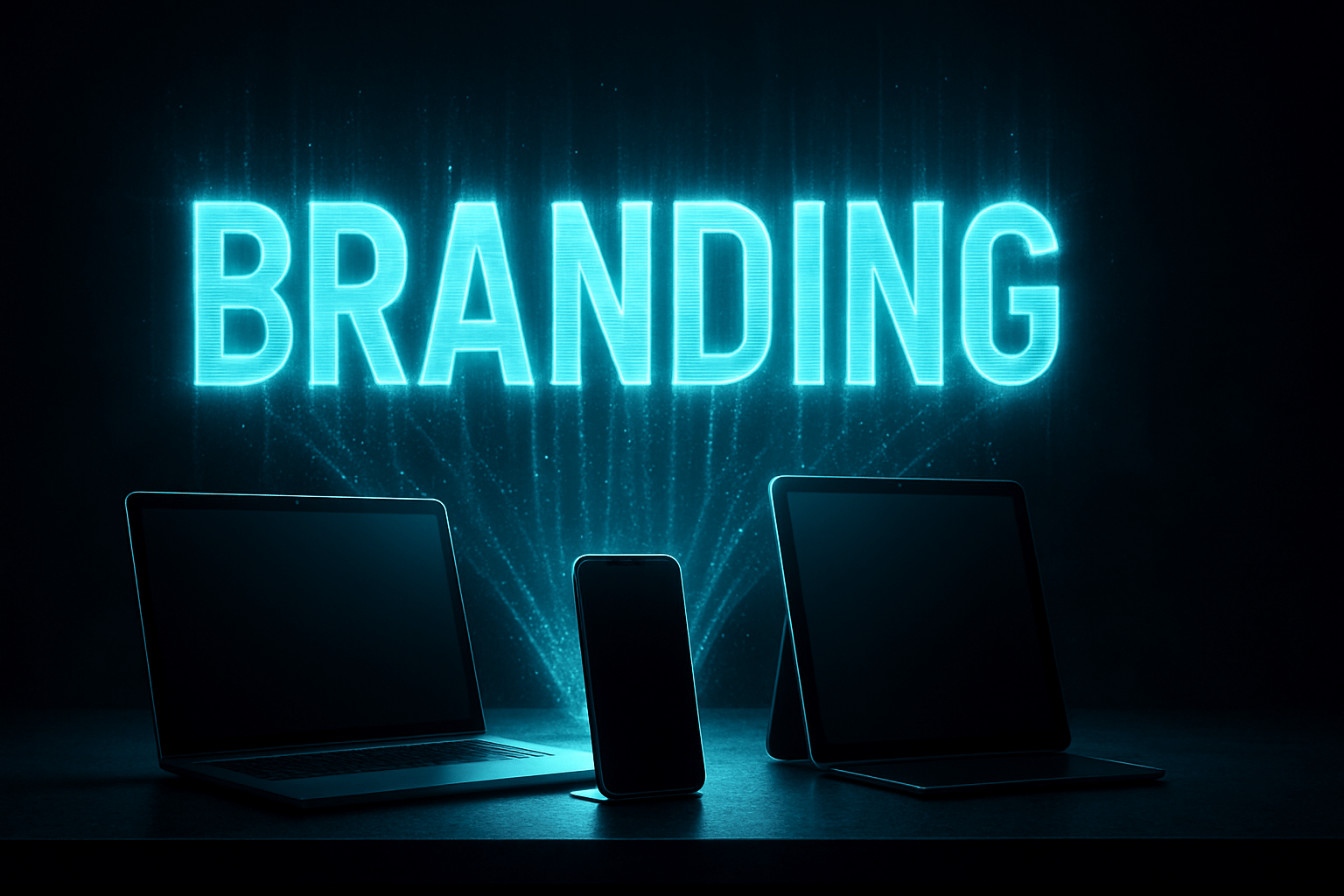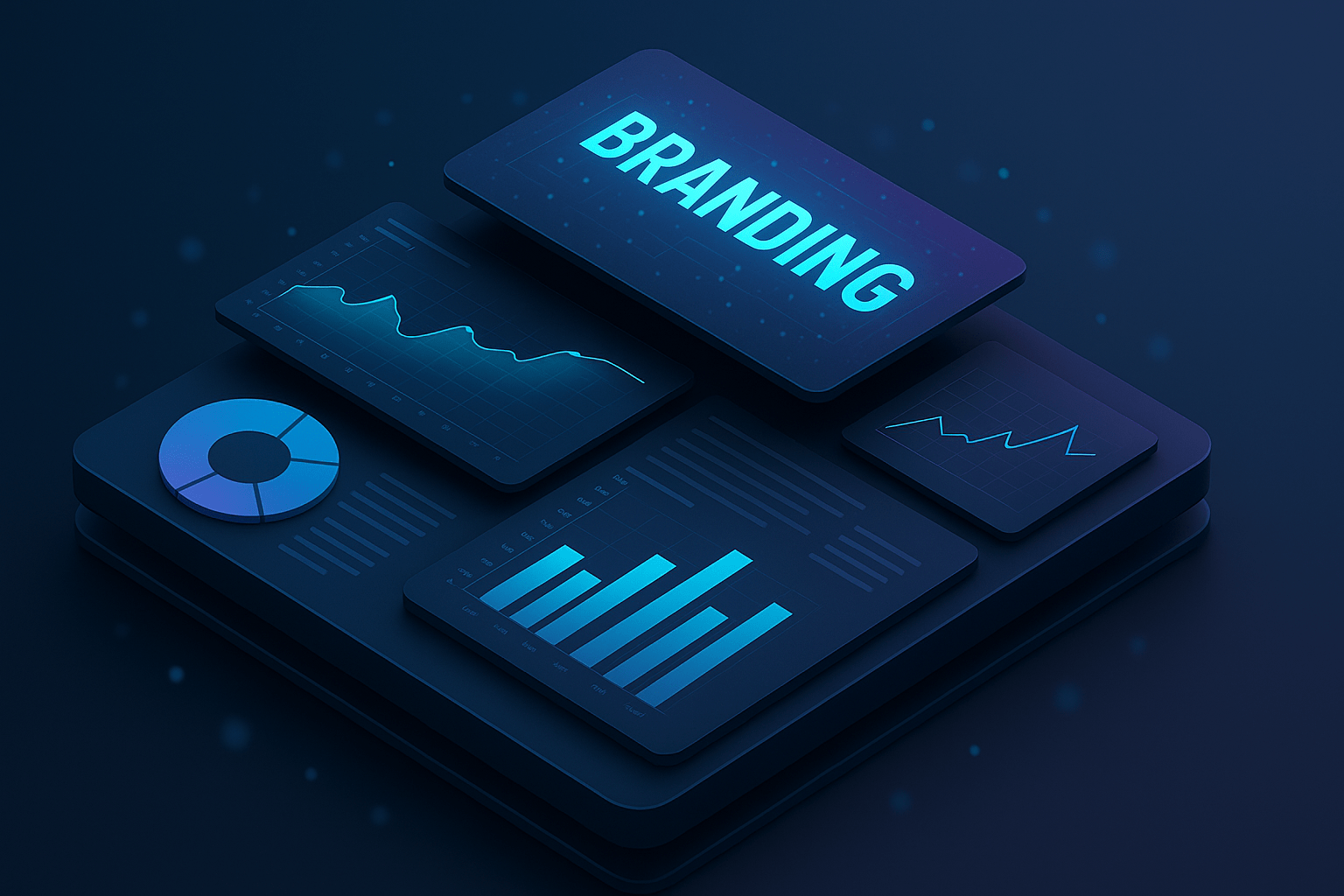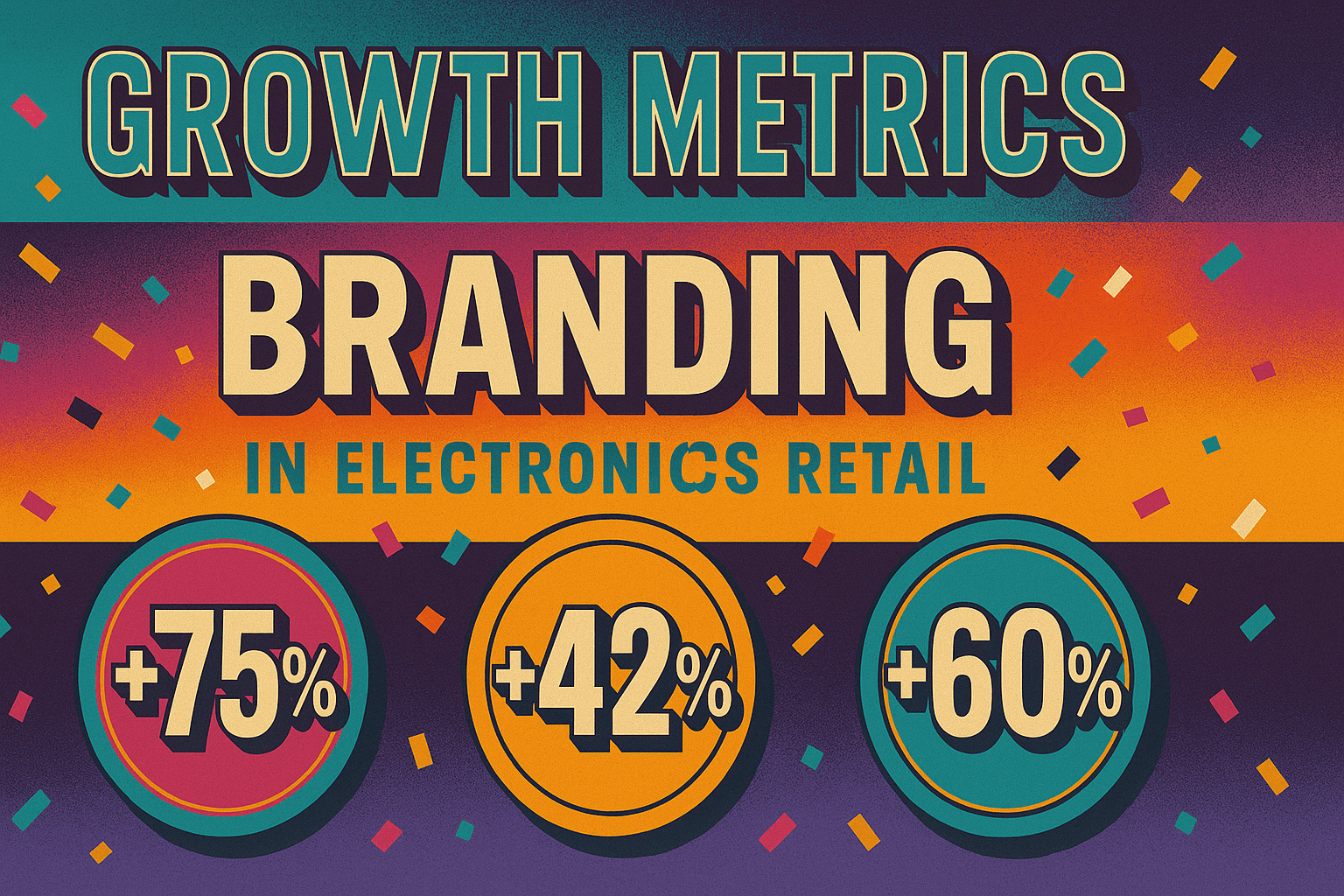How to Build a Winning Brand Strategy for Electronics Retail in 2026
by Design Delulu Editorial · October 19, 2025

Smart, fast, and measurable. Here's how Branding helps Electronics Retail win.
In electronics retail, your brand isn't just a logo or color scheme—it's the measurable difference between browsers and buyers. With average cart abandonment rates exceeding 70% and customer acquisition costs climbing annually, electronics retailers need branding that directly connects to revenue, not just awareness. The stakes are clear: brands that integrate measurement, messaging, and user experience from day one outperform competitors by capturing intent at every touchpoint.
Modern electronics retail branding goes far beyond visual identity. It requires data-driven tracking systems, attribution models that reveal which channels actually drive sales, and dashboards that provide real-time insights into customer behavior. Whether you're launching a new electronics brand or refreshing an established retailer, this blueprint shows you how to build a brand foundation that scales with your growth while maintaining the agility to adapt to rapidly shifting consumer preferences and market trends.

Why Electronics Retail Branding Requires a Different Approach
Electronics retail operates in a uniquely challenging landscape. Customers conduct extensive research before purchasing, comparing specs across multiple sites. They expect detailed product information, transparent pricing, and social proof at every stage. Your brand must deliver trust signals instantly while providing the technical depth serious buyers demand.
The traditional branding playbook falls short here. Generic brand guidelines and one-off campaigns don't address the complex attribution challenges electronics retailers face. A customer might discover your brand through a YouTube review, research on your site multiple times, compare prices on aggregator sites, and finally convert through a retargeting ad. Without proper tracking and attribution modeling, you can't identify which brand touchpoints actually drive revenue.
The Three Pillars of Modern Electronics Retail Branding
Successful electronics retail brands are built on three interconnected pillars:
- Measurement Infrastructure: GA4 implementation, server-side tracking, and clean data governance that captures every customer interaction across devices and sessions
- Brand Positioning: Messaging frameworks that speak to both technical specifications and emotional benefits, positioning your store as the authoritative source for electronics purchases
- Optimization Systems: Dashboards, attribution models, and testing protocols that turn data into actionable improvements across your entire customer journey
These pillars work together. Your measurement infrastructure reveals which messaging resonates. Your brand positioning creates differentiated touchpoints to measure. Your optimization systems ensure continuous improvement based on real performance data, not assumptions.
The 6-Step Framework for Electronics Retail Branding
This framework has been refined through dozens of electronics retail engagements. It's designed to deliver measurable results quickly while building a sustainable foundation for long-term growth.
Step 1: Discovery & Goal Alignment
Every successful branding project begins with clarity. During discovery, we identify your core business objectives, competitive landscape, and current brand performance. This isn't about creating mood boards—it's about understanding which metrics matter most to your business.
Key activities include:
- Revenue analysis: Identify your highest-value customer segments and products
- Competitive audit: Map how competitors position themselves and where gaps exist
- Current state assessment: Evaluate existing brand assets, tracking setup, and data quality
- Success metrics definition: Establish clear KPIs that tie branding efforts to business outcomes
The outcome is a shared understanding of what success looks like. For most electronics retailers, this means increasing qualified traffic, improving conversion rates, and building customer lifetime value—all measurable through proper tracking.
Step 2: Strategic Blueprint Development
With goals defined, we develop the strategic blueprint that guides all implementation. This includes your brand architecture, messaging hierarchy, visual system, and comprehensive measurement plan.
The blueprint addresses critical questions:
- What makes your electronics retail brand distinctly valuable to customers?
- How should messaging adapt across awareness, consideration, and purchase stages?
- Which channels and touchpoints deserve priority investment?
- How will you attribute success across multiple customer interactions?
For electronics retail specifically, the blueprint must account for long consideration cycles and multi-device browsing patterns. Your brand needs to maintain consistency whether customers encounter you on mobile, desktop, or in-app environments, while adapting messaging to match their journey stage.
Step 3: Measurement Infrastructure Setup
Before launching any brand assets, establish proper measurement infrastructure. This is non-negotiable for electronics retail where attribution complexity can make or break your understanding of ROI.
Implementation includes:
- GA4 configuration: Event tracking for product views, add-to-cart actions, checkout steps, and purchases with proper e-commerce parameters
- Server-side tagging: Reduces data loss from ad blockers and provides more accurate attribution in privacy-first environments
- Data layer implementation: Ensures consistent, clean data capture across your entire site and app ecosystem
- Cross-domain tracking: Maintains user sessions across multiple domains or subdomains in your brand ecosystem
This foundation enables everything that follows. Without reliable data, you're making brand decisions based on intuition rather than evidence. Electronics retailers with proper measurement infrastructure typically see 15-30% improvements in reported conversion rates simply from eliminating tracking gaps.
Step 4: Brand Asset Development & Implementation
With strategy and measurement in place, develop and deploy your brand assets. For electronics retail, this goes well beyond visual identity to include content frameworks, product presentation systems, and conversion-optimized page templates.
Key deliverables include:
- Visual identity system: Logo variations, color palette, typography, and iconography optimized for digital environments
- Messaging framework: Value propositions, category descriptions, and product copy templates that balance technical specs with benefits
- Page templates: Homepage, category pages, product detail pages, and landing pages designed for conversion
- Content systems: Blog templates, buying guides, and comparison tools that support the customer journey
Each asset is developed with measurement in mind. Every template includes proper event tracking. Every message variant gets tagged for attribution. This ensures you can quickly identify which brand elements drive performance and which need refinement.

Step 5: Dashboard & Attribution Model Configuration
Raw data means nothing without proper interpretation. Build Looker Studio dashboards that provide actionable insights at a glance, configured specifically for electronics retail metrics.
Your dashboard ecosystem should include:
- Executive overview: Revenue, traffic, conversion rate, and customer acquisition cost trends
- Channel performance: Attribution-weighted analysis showing true contribution of each marketing channel
- Product analytics: Best-sellers, margin analysis, and inventory turnover by category
- Customer journey mapping: Path analysis showing common routes from discovery to purchase
Attribution modeling is particularly critical. Last-click attribution typically under-credits brand-building activities that generate awareness and consideration. Implement data-driven or time-decay models that properly weight touchpoints across the customer journey. This ensures your branding investments get appropriate credit for pipeline generation.
Step 6: Testing, Optimization & Scaling
Launch isn't the end—it's the beginning of continuous improvement. Establish regular testing cadences to optimize brand performance based on real customer behavior.
Optimization focuses include:
- Messaging tests: A/B test headlines, value propositions, and call-to-action variations to improve conversion rates
- Page layout experiments: Test product presentation formats, image prominence, and information hierarchy
- Channel mix optimization: Reallocate budget based on attribution data to maximize ROI
- Content performance analysis: Double down on content formats and topics that drive engagement and conversions
Create a weekly review cadence to assess performance against KPIs and identify optimization opportunities. Conduct quarterly strategic reviews to evaluate whether your brand positioning and messaging still align with market conditions and customer preferences. Electronics retail moves quickly—your brand must evolve with it.
Key Benefits of This Branding Approach
This framework delivers tangible advantages over traditional branding approaches:
- Event + ecommerce tracking with GA4/server tagging: Capture complete customer journey data across devices and sessions, even as third-party cookies disappear
- Source-of-truth dashboards in Looker Studio: Eliminate debate about performance with unified, real-time reporting accessible to all stakeholders
- Attribution modeling that matches your funnel: Understand true ROI of brand-building activities rather than over-crediting last-click conversions
- Governance for consistent, clean data: Establish protocols that ensure data quality remains high as your team and tech stack evolve
These benefits compound over time. Better data leads to better decisions. Better decisions improve performance. Improved performance generates more revenue to invest in optimization. Electronics retailers using this approach typically see 2-3x ROI within the first year through improved conversion rates and reduced customer acquisition costs.
Industry-Specific Best Practices for Electronics Retail Branding
Electronics retail has unique characteristics that demand specialized approaches. Apply these best practices to maximize your branding effectiveness:
Align Brand Messaging with Buyer Journey Stages
Map search intent to specific buyer stages. Someone searching for 'best noise cancelling headphones' is in early research mode—serve educational content that positions your brand as authoritative. Someone searching for 'Sony WH-1000XM5 price' is ready to buy—show pricing, availability, and fast shipping prominently.
Create distinct messaging for each stage:
- Awareness: Educational content, category guides, and comparison tools that build trust
- Consideration: Detailed specs, customer reviews, and use-case scenarios that aid decision-making
- Purchase: Clear pricing, inventory status, shipping options, and return policies that remove friction
- Retention: Setup guides, warranty information, and accessory recommendations that build loyalty
Deploy Social Proof Strategically
Use social proof and outcomes early in the journey. Electronics buyers are risk-averse—they're spending significant money on technical products they may not fully understand. Surface customer reviews, expert ratings, and purchase counts prominently on category and product pages.
Effective social proof includes:
- Star ratings and review counts above the fold on product pages
- Customer photos and videos showing products in real-world use
- Expert certifications and awards from trusted technology publications
- Purchase indicators like 'X customers bought this in the last 24 hours'
Maintain a Single Source of Truth
Measure against a single source of truth dashboard. Electronics retail involves multiple systems—your ecommerce platform, CRM, advertising platforms, and analytics tools. Don't let conflicting numbers create confusion or slow decision-making.
Establish one primary dashboard (typically in Looker Studio or your BI platform) that serves as the definitive source for performance metrics. All stakeholders should reference this dashboard for decision-making, ensuring alignment across marketing, merchandising, and executive teams.
Embrace Rapid Iteration
Ship small, test fast, keep compounding wins. Don't wait for perfect—launch brand improvements in phases and optimize based on real customer behavior. Update a single product category template and measure results before rolling out site-wide. Test new messaging on landing pages before updating your entire site.
This approach reduces risk while accelerating learning. Small wins compound into significant improvements over quarters and years. Electronics retail brands that embrace rapid testing consistently outperform those that launch infrequently with major overhauls.
Essential Deliverables for Electronics Retail Branding
A complete branding engagement produces specific deliverables that enable ongoing success:
Strategic Documentation
- Brand positioning statement: Your unique value proposition and competitive differentiation
- Messaging hierarchy: Primary and secondary messages for different audiences and journey stages
- Voice and tone guidelines: How your brand communicates across channels and contexts
Visual Identity System
- Logo and mark variations: Primary, secondary, and icon versions optimized for digital use
- Color system: Primary, secondary, and functional colors with specific use cases
- Typography: Font families, sizes, and weights for headers, body copy, and UI elements
- Iconography and imagery guidelines: Icon library and product photography standards
Technical Implementation
- Tracking plan: Comprehensive documentation of all events, parameters, and data layer variables
- GA4/Server-side setup: Fully configured analytics with ecommerce tracking and custom events
- Dashboards: Looker Studio reports for executive, channel, product, and customer analytics
- Attribution model settings: Configured models that properly credit brand touchpoints
Operational Tools
- Page templates: HTML/CSS for key page types with built-in tracking
- Content templates: Blog posts, buying guides, and product description frameworks
- Brand asset library: Organized repository of logos, images, and design elements
- Testing playbook: Framework for conducting and analyzing brand experiments

Common Pitfalls to Avoid in Electronics Retail Branding
Learn from common mistakes that derail electronics retail branding projects:
Prioritizing Aesthetics Over Performance
Beautiful brand assets that don't convert are expensive art projects, not business tools. Every design decision should be validated against performance metrics. If a sleek, minimal product page converts worse than a information-dense version, prioritize conversion over aesthetics.
Ignoring Mobile Experience
Over 60% of electronics research happens on mobile devices, yet many brands still design desktop-first. Ensure your brand experience is optimized for mobile browsing patterns, smaller screens, and touch interfaces. Test performance metrics separately for mobile and desktop—they often reveal different optimization priorities.
Treating Branding as One-Time Project
Markets shift. Customer preferences evolve. Competitors launch new initiatives. Your brand can't remain static. Budget for ongoing optimization and periodic refresh cycles. The most successful electronics retailers treat branding as a continuous process, not a project with an end date.
Insufficient Technical Specs
Electronics buyers need detailed technical information. Don't sacrifice specs for cleaner design. Find creative ways to present technical details that serve both casual browsers and specification-focused buyers. Expandable sections, comparison tables, and spec sheets satisfy different user needs.
How to Get Started with Electronics Retail Branding
Ready to build a brand that drives measurable growth? Here's your starting point:
Assess Your Current State
Evaluate your existing brand foundation:
- Do you have clear brand positioning that differentiates you from competitors?
- Is your analytics setup capturing complete customer journey data?
- Can you confidently attribute revenue to specific marketing channels and campaigns?
- Do you have dashboards that enable quick, data-driven decisions?
If you answered 'no' to any of these questions, you have opportunities for significant improvement.
Define Your Priorities
Not every electronics retailer needs the full framework immediately. Prioritize based on your biggest constraints:
- If you lack tracking: Start with measurement infrastructure—you can't optimize what you can't measure
- If you have data but no insights: Focus on dashboards and attribution modeling to turn data into action
- If your positioning is unclear: Begin with strategic work to define your unique value proposition
- If you're ready to scale: Implement the complete framework to build sustainable competitive advantage
Choose Your Approach
You have two paths forward:
Build in-house: Use this blueprint to guide internal efforts. This works if you have skilled brand strategists, designers, and analytics professionals on staff. Budget 3-6 months for implementation depending on team availability.
Partner with specialists: Work with experts who have implemented this framework across multiple electronics retailers. This accelerates timeline to 4-8 weeks and brings specialized expertise in electronics retail buyer behavior and measurement best practices.
Frequently Asked Questions
Let’s level up your Electronics Retail business
Need services that actually move the needle for Electronics Retail? See our approach, pricing, and timelines—then book a quick call.
Additional Resources
- Schedule Your Strategy Call
Book a 30-minute consultation to discuss your electronics retail branding needs, review your current setup, and explore how our framework can accelerate your growth.
- View Our Electronics Retail Portfolio
Explore completed branding projects for electronics retailers including tracking implementations, dashboard designs, and brand identity systems that drove measurable revenue growth.
- Free Electronics Retail Tools
Access free resources including brand audit templates, tracking plan frameworks, dashboard templates, and conversion optimization checklists designed specifically for electronics retailers.
Related Reading

Master advanced branding for SaaS & tech startups with proven frameworks, positioning strategies, and scalable systems that drive growth and customer loyalty.

Transform your event venue with strategic branding that attracts clients, increases bookings, and builds lasting recognition. Proven framework, measurable results.
